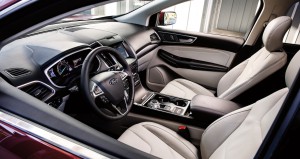
Car interiors often put off odors related to the volatile organic compounds used to assemble them. The VOCs are unhealthy and Ford has found a way to deal with them.
Making a new car greener entails many things, including but not exclusively, improved fuel economy, lower greenhouse gas emissions and easier recyclability.
Automakers around the globe have been searching for ways to make the interior cabin better for occupants. By changing the materials they use for steering wheels, seats and other components, they’re lowering the volatile organic compounds that fill the cabin.
Additionally, there are other chemicals and compounds used in the assembly of vehicles that add to the harmful nature, and ultimately the smell of new vehicles. Eliminating these VOCs makes for a vehicle that’s less harmful to occupants — and adds to automaker’s bottom line too.
Americans love that “new car smell,” which is generated by the aforementioned VOCs, but for much of the last five years there’s been a concentrated effort to eliminate it. Why? Because Chinese buyers can’t stand it and since China’s the world’s largest automotive market, it makes sense to cater to their tastes.
(To check out our first drive in the new Chevy Silverado 2.7L, Click Here.)
Ford Motor Co. has been leading the way in this for some time. Recently the Dearborn, Michigan-based automaker filed a patent application for an odor-removal process that eliminates the new car smell after a vehicle has been purchased by a customer.
“Unpleasant interior smell/odor remains the top industry problem in that market,” Brent Gruber, senior director, global automotive, at J.D. Power told the Detroit Free Press. “To put that in context, it is nearly double the problem rate of the second most prevalent problem, excessive fuel consumption.”
The problem has been to subject to research for some time to find a solution. Research shows the elemental composition of the materials includes the presence of potentially hazardous chemicals, such as BFRs, PVC, and possibly phthalate plastics.
Car interiors are like chemical reactors, with temperatures reaching extremes of up to 192 degrees Fahrenheit, according to a WebMD-sponsored study. The high temperatures can increase the concentration of VOCs in the car and speed the breakdown of materials.
(Click Here for more about Toyota’s new RAV4 hybrid.)
Exposure to toxic chemicals can be high indoors and in enclosed spaces like a car interior. Drivers are exposed to these chemicals by breathing and contact with dust, the website noted.
According the Environmental Protection Agency, indoor air pollution is one of the top environmental threats to public health, and with the amount of time Americans spend in automobiles, the exposure to those toxins can be heightened.
Ford’s new process, as described in the patent, involves parking the vehicle outside in the sun, opening the windows slightly, and optionally turning the engine, heater and fan on. The system sues specialized software and a slew of air quality sensors to run the process.
The car would determine whether conditions are right to expel compounds, and the car would drive itself to a place in the sun and bake away the offensive odor.
(All-new Honda Passport set to debut at L.A. Auto Show. Click Here for the story.)
Ford isn’t alone in working on this “problem.” Volkswagen, Hyundai, Kia and Mitsubishi have all programs designed to resolve “new car” smell.
